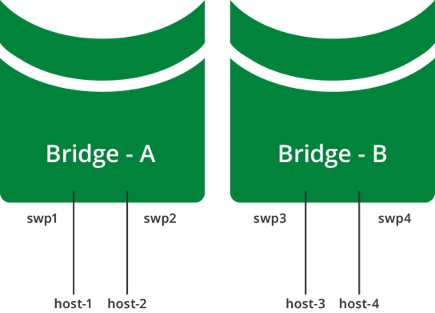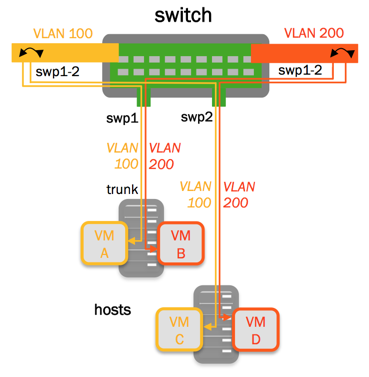Traditional Bridge Mode
For a traditional Linux bridge, the kernel supports VLANs in the form of VLAN subinterfaces. Enabling bridging on multiple VLANs means configuring a bridge for each VLAN and, for each member port on a bridge, creating one or more VLAN subinterfaces out of that port. This mode poses scalability challenges in terms of configuration size as well as boot time and run time state management, when the number of ports times the number of VLANs becomes large.
Using a VLAN-aware bridge on your switch is recommended. Use traditional mode bridges only if you need to run more than one bridge on the switch or if you need to use PVSTP+.
Configure a Traditional Mode Bridge
The following examples show how to create a simple traditional mode bridge configuration on the switch. The example also shows some optional elements:
- You can add an IP address to provide IP access to the bridge interface.
- You can specify a range of interfaces.
To configure spanning tree options for a bridge interface, refer to Spanning Tree and Rapid Spanning Tree - STP.
The following example commands configure a traditional mode bridge called my_bridge with IP address 10.10.10.10/24. swp1, swp2, swp3, and swp4 are members of the bridge.
cumulus@switch:~$ net add bridge my_bridge ports swp1-4
cumulus@switch:~$ net add bridge my_bridge ip address 10.10.10.10/24
cumulus@switch:~$ net pending
cumulus@switch:~$ net commit
Edit the /etc/network/interfaces file, then run the ifreload -a command. The following example command configures a traditional mode bridge called my_bridge with IP address 10.10.10.10/24. swp1, swp2, swp3, and swp4 are members of the bridge.
...
auto swp1
iface swp1
auto swp2
iface swp2
auto swp3
iface swp3
auto swp4
iface swp4
auto my_bridge
iface my_bridge
address 10.10.10.10/24
bridge-ports swp1 swp2 swp3 swp4
bridge-vlan-aware no
...
cumulus@switch:~$ sudo ifreload -a
cumulus@switch:~$ cl set
cumulus@switch:~$ cl config apply
The name of the bridge must be:
- Compliant with Linux interface naming conventions.
- Unique within the switch.
- Something other than bridge, as Cumulus Linux reserves that name for a single VLAN-aware bridge.
Do not try to bridge the management port, eth0, with any switch ports (swp0, swp1, and so on). For example, if you create a bridge with eth0 and swp1, it does not work.
Configure Multiple Traditional Mode Bridges
You can configure multiple bridges to logically divide a switch into multiple layer 2 domains. This allows for hosts to communicate with other hosts in the same domain, while separating them from hosts in other domains.
The diagram below shows a multiple bridge configuration, where host-1 and host-2 are connected to bridge-A, while host-3 and host-4 are connected to bridge-B:
- host-1 and host-2 can communicate with each other
- host-3 and host-4 can communicate with each other
- host-1 and host-2 cannot communicate with host-3 and host-4

This example configuration looks like this in the /etc/network/interfaces file:
...
auto bridge-A
iface bridge-A
bridge-ports swp1 swp2
bridge-vlan-aware no
auto bridge-B
iface bridge-B
bridge-ports swp3 swp4
bridge-vlan-aware no
...
Trunks in Traditional Bridge Mode
The standard for trunking is 802.1Q. The 802.1Q specification adds a 4 byte header within the Ethernet frame that identifies the VLAN of which the frame is a member.
802.1Q also identifies an untagged frame as belonging to the native VLAN (most network devices default their native VLAN to 1). The concept of native, non-native, tagged or untagged has generated confusion due to mixed terminology and vendor-specific implementations. In Cumulus Linux:
- A trunk port is a switch port configured to send and receive 802.1Q tagged frames.
- A switch sending an untagged (bare Ethernet) frame on a trunk port is sending from the native VLAN defined on the trunk port.
- A switch sending a tagged frame on a trunk port is sending to the VLAN identified by the 802.1Q tag.
- A switch receiving an untagged (bare Ethernet) frame on a trunk port places that frame in the native VLAN defined on the trunk port.
- A switch receiving a tagged frame on a trunk port places that frame in the VLAN identified by the 802.1Q tag.
A bridge in traditional mode has no concept of trunks, just tagged or untagged frames. With a trunk of 200 VLANs, there would need to be 199 bridges, each containing a tagged physical interface, and one bridge containing the native untagged VLAN. See the examples below for more information.
The interaction of tagged and un-tagged frames on the same trunk often leads to undesired and unexpected behavior. A switch that uses VLAN 1 for the native VLAN may send frames to a switch that uses VLAN 2 for the native VLAN, thus merging those two VLANs and their spanning tree state.
Trunk Example

To create the above example:
cumulus@switch:~$ net add bridge br-VLAN100 ports swp1.100,swp2.100
cumulus@switch:~$ net add bridge br-VLAN200 ports swp1.200,swp2.200
cumulus@switch:~$ net pending
cumulus@switch:~$ net commit
Add the following configuration to the /etc/network/interfaces file:
...
auto br-VLAN100
iface br-VLAN100
bridge-ports swp1.100 swp2.100
auto br-VLAN200
iface br-VLAN200
bridge-ports swp1.200 swp2.200
...
cumulus@switch:~$ cl set
cumulus@switch:~$ cl config apply
VLAN Tagging Examples
For more VLAN tagging examples, see VLAN Tagging.
Considerations
On Broadcom switches, when two VLAN subinterfaces are bridged to each other in a traditional mode bridge, switchd does not assign an internal resource ID to the subinterface, which is expected for each VLAN subinterface. To work around this issue, add a VXLAN on the bridge so that it does not require a real tunnel IP address.